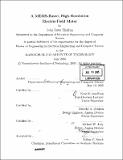A MEMS-based, high-resolution Electric-Field meter
Author(s)
Shafran, John Sawa
DownloadFull printable version (11.52Mb)
Alternative title
Microelectromechanical systems-based, high-resolution ESF
Other Contributors
Massachusetts Institute of Technology. Dept. of Electrical Engineering and Computer Science.
Advisor
Kent H. Lundberg, Timothy A. Denison and Michael W. Judy.
Terms of use
Metadata
Show full item recordAbstract
In MEMS-based inertial sensors, such as accelerometers and gyroscopes, known electrical waveforms are applied to a modulating capacitive element to determine an unknown deflection. However, the inverse of this scheme can also be exploited - the capacitive element can be deterministically modulated to measure an electrostatic variable. This thesis presents the design, analysis, and evaluation of such a sensor -a MEMS-based, high-resolution electrostatic field-meter (ESF) - using the Analog Devices iMEMS process. High-resolution sensing is achieved by optimizing the interface electronics for low-noise operation and applying feedback techniques to enhance the range-of-motion of the MEMS capacitive structure. The entire system consists of three components: the MEMS capacitive structure and two circuit subsystems - the sense block and the drive loop. The MEMS structure acts as a transducer to generate a dynamic current that is proportional to the magnitude and polarity of the electric field incident on the sensor. The drive loop is a closed feedback loop that modulates the MEMS capacitive structure at its resonant frequency to maximize its displacement and the magnitude of the dynamic current. The sense block ultimately converts the dynamic current into a dc voltage that is proportional to the magnitude and polarity of the incident electric field. The critical, front-end component of the sense block, a transimpedance amplifier, is implemented with a low-noise operational amplifier for optimum sensing resolution.
Description
Thesis (M. Eng.)--Massachusetts Institute of Technology, Dept. of Electrical Engineering and Computer Science, 2005. Includes bibliographical references (p. 169-172).
Date issued
2005Department
Massachusetts Institute of Technology. Department of Electrical Engineering and Computer SciencePublisher
Massachusetts Institute of Technology
Keywords
Electrical Engineering and Computer Science.